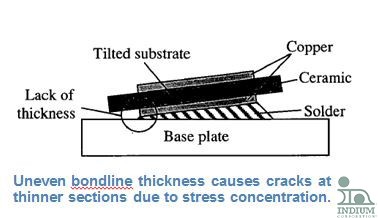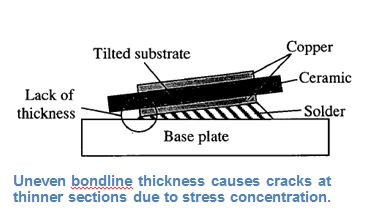The next few posts come to us from my colleagues Karthik Vijay, Indium Corporation’s Technical Manager for Europe and Liam Mills of TT Electronics Power and Hybrid. They’ve done some exciting work using InFORM® technology to make more reliable solder joints at a lower cost than traditional techniques.
– Tim Jensen
When uneven solder bondline thicknesses exists between the substrate and baseplate of an IGBT module, stress becomes concentrated at the thinner sections1. This stress can cause delamination and premature failure during the operational life of the module.
The key to preventing this delamination is to achieve uniform bondline thickness, which is traditionally accomplished by stitching and trimming wirebonds to the required bondline at the corners of the substrate/baseplate. Then, regular soldering is performed.
The problem with this method is that there are extra costs associated with the additional process steps of wirebonding, trimming, and removal of the wirebond foot. My colleague Liam and I wanted to see if there was a way that we could save time and money by changing the process.
Parts II and III of this series will explore a working partnership study in which TT Electronics Power and Hybrid sought to eliminate these additional process steps. In this study, TT Electronics Power and Hybrid prepared test samples using InFORMS®, which were evaluated at TT Electronics Semelab in-house testing facility, as an alternate technique to maintain uniform solder bondline thickness. InFORMS® are revolutionary solder preforms with a braided metal mesh embedded into them.
Two manufacturing techniques were tested for an aerospace application with thermal cycling reliability specifications of -55/+150°C, 1,500 passive cycles. Failure was defined as delamination greater than 50% of substrate/baseplate area and a 200µm-thick desired bondline thickness.
Check back for parts II and III to see how InFORMS® performed, compared to trimmed wirebonds.
Best,
Karthik Vijay, Indium Corporation, UK, kvijay@indium.com and
Liam Mills, TT Electronics Power and Hybrid, UK, liam.mills@semelab-tt.com
References
- K. Hayashi & G. Izuta, “Improvement of Fatigue Life of Solder Joints by Thickness Control of Solder with Wire Bump Technique,” ECTC 2002, www.cpmt.org/proceedings/



